#Michiel Jansz. van Mierevelt
Explore tagged Tumblr posts
Text


1632 Michiel Jansz. van Mierevelt - Willem Ruychaever
(Museum Van Loon)
186 notes
·
View notes
Text

Michiel Jansz. van Mierevelt (Netherlandish, ca.1566-1641) Ambrogio Spinola, Spanish General, 1633 Rijksmuseum, Amsterdam
#Michiel Jansz. van Mierevelt#netherlandish#dutch#dutch art#spanish#italian#art#fine art#fine arts#classical art#spanish general#western civilization#spinola#male#portrait#male portrait#1500s#1600s#knight#medieval#renaissance#european art#europe#european#oil painting#mediterranean#europa#amsterdam#brunette#hispanic
29 notes
·
View notes
Text
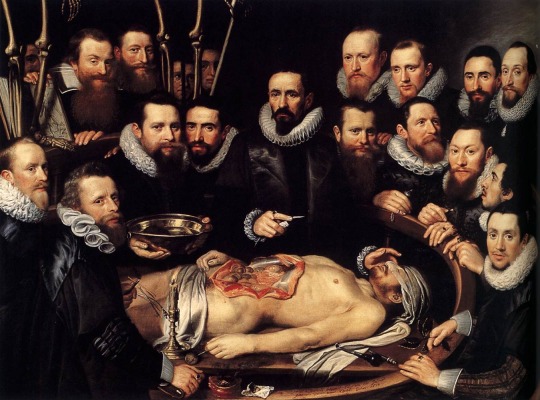
Anatomy Lesson of Dr. Willem van der Meer (1617, oil on canvas) | Michiel Jansz. van Mierevelt
#art#fine art#painting#oil painting#17th century#anatomy lesson of dr willem van der meer#michiel jansz van mierevelt
3K notes
·
View notes
Text
Retrato de mujer, por Michiel Jansz. van Mierevelt
Este cuadro, que retrata a una mujer cuya identidad desconocemos, fue pintado por Michiel Jansz van Mierevelt en 1625. Es un óleo sobre lienzo que podemos ver a día de hoy en el Museo de Bellas Artes de Lyon. En primer lugar, vamos a ver quién es el pintor al que nos estamos refiriendo: Continue reading Retrato de mujer, por Michiel Jansz. van Mierevelt

View On WordPress
2 notes
·
View notes
Text

Anatomy Lesson of Doctor Willem van der Meer (1617)
— by Michiel Jansz. van Mierevelt
#painting#art#artblr#oil on canvas#oil painting#art history#classical art#goth#gothic#dark art#whump#whumpblr#medical whump#hospital whump#artist#dark academia#anatomy#classic academia#gothcore#academia aesthetic#artists#art community#art gallery#fine art#art blog
978 notes
·
View notes
Text

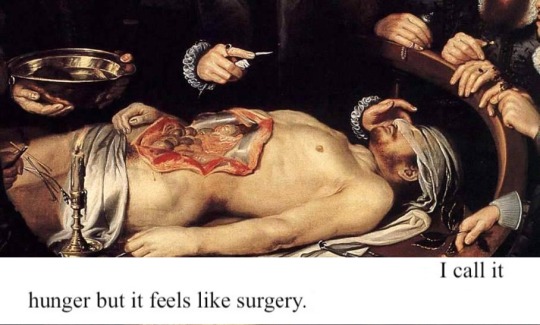



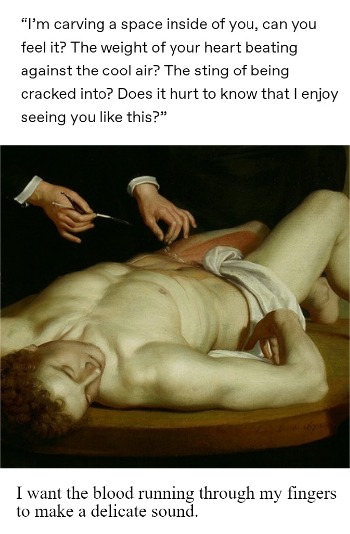


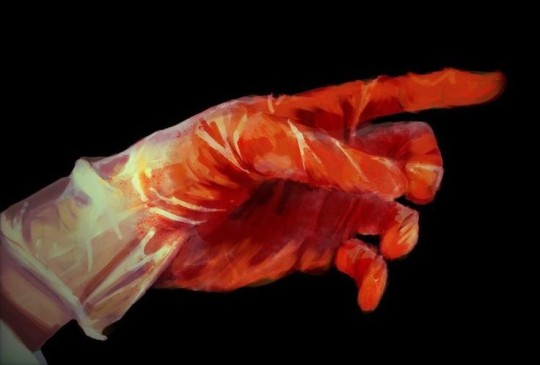
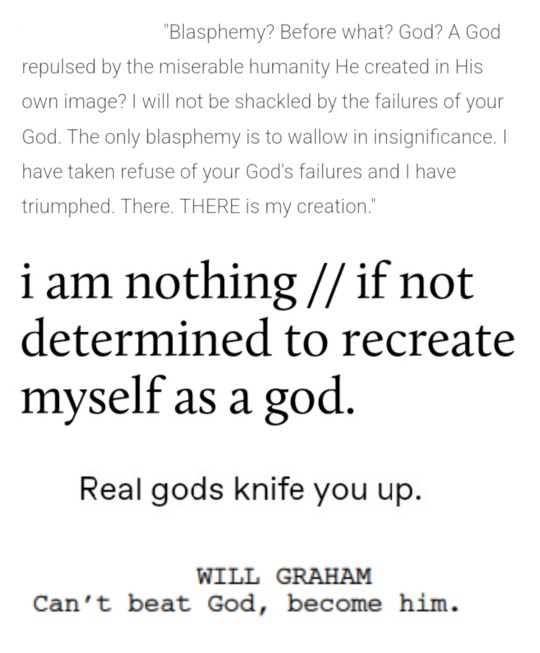
web weaving for my oc, Graves
Re-animator dir. Stuart Gordon / No Ghost Abandoned, Tyree Daye / Another Last Day, Aex Lemon / Anatomy Lesson of Dr. Willem van Der Meer, Michiel Jansz van Mierevelt / Jenny Holzer / Practice of Autopsies, G. Reign / The Book of X, Rose Etter / haruspice, Yves Olade / self portrait as a murderer, Juliusz Lewandowski / Love via Purpose, I.B. Vyache / Anatomy Lesson by Dr. F. Ruysch, Adriaen Backer / Blood Wedding, Federico Garcia Lorca / The Gross Clinic, Thomas Eakins / On The Romance of Cannibalism, Silas Denver Melvin / Blood Tin Straw, Sharon Olds / All the Wrong Colours, Yrsa Daley-Ward / Bride of Re-animator dir. Brain Yuzna / Baby Teeth, Laura Villareal / I Keep a Strange List, Talin Tahajian / Hannibal 1x05
784 notes
·
View notes
Text
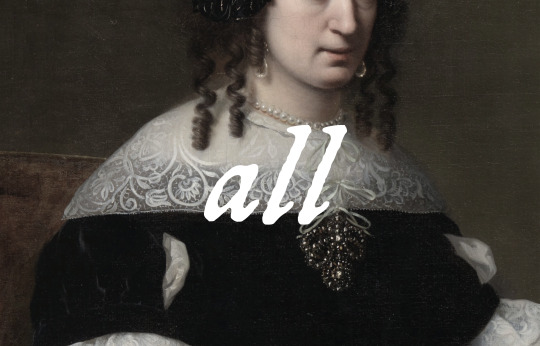
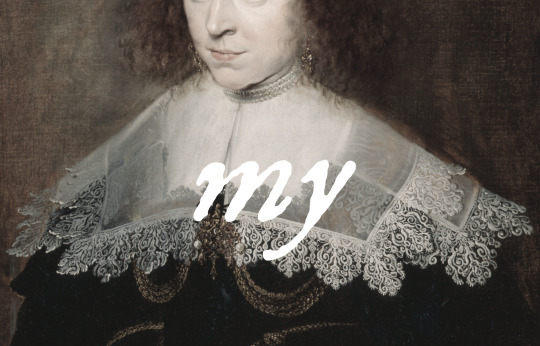

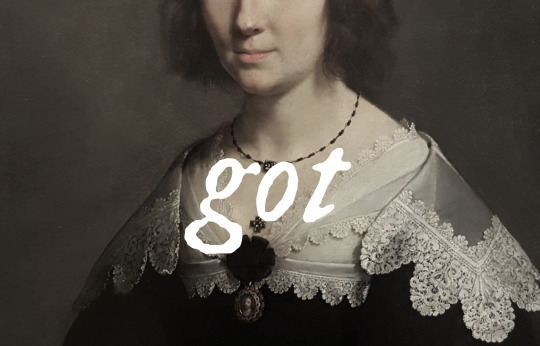


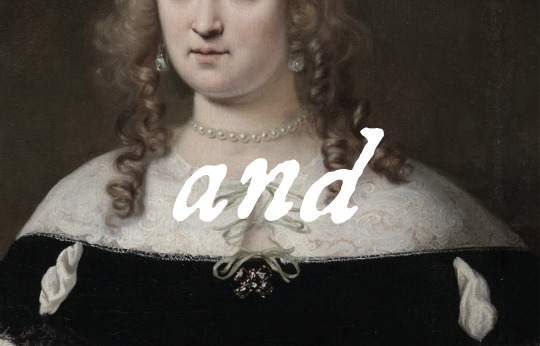

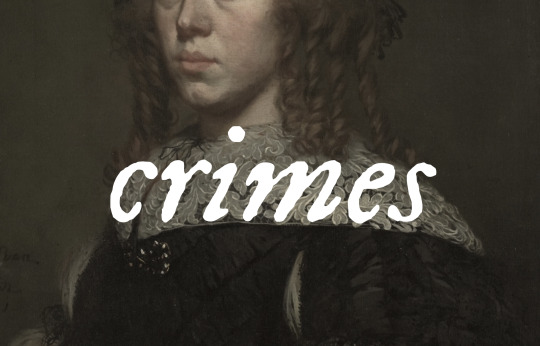
women with lace collars in art x florida!!!
Portrait of the Three Regentesses of the Leprozenhuis, Amsterdam – Ferdinand Bol // Portrait of a Young Woman – unknown artist // Adriana Jacobusdr Hinlopen – Lodewijk van der Helst // Portrait of Charlotte Duchesne, the Artist’s Wife – Philippe de Champaigne // Portrait of a Lady – Nicolaes Maes // Portrait of Geertruyt van der Dussen – Wybrand de Geest and Michiel Jansz van Mierevelt // Portrait of the Three Regentesses of the Leprozenhuis, Amsterdam – Ferdinand Bol // Portrait of Aletta van Ravensberg – Ludolf de Jongh // Portrait of a Woman – Pieter van Anraedt // Florida!!! – Taylor Swift feat. Florence + the Machine
#sorry for the inactivity y'all!#my phd program started and it's been a little crazy#so please accept this silly little edit that came to me while i was riding the bus to campus lol#florida!!!#the tortured poets department#ttpd#tortured poets department#florence + the machine#florence and the machine#fatm#f+tm#taylor swift#ts edit#tsedit#tswiftedit#tswiftlyrics#ts lyrics#tswift edits#tswift lyrics#art#art history#lyrics#lyric art
145 notes
·
View notes
Text

"Portrait of Ambrogio Spinola", (1609–1633), by Michiel Jansz van Mierevelt (). Dutch painter and draftsman. oil on panel
109 notes
·
View notes
Text

“Hidden van Mierevelt IV” - Volker Hermes 2022 - from the original “Portrait of a Man in a White Frill” by Michiel Jansz. van Mierevelt, 1620
18 notes
·
View notes
Photo

"Elisabeth Stuart, Reine de Bohême" copie d'après Michiel Jansz van Mierevelt (circa 1623) présentée à l'exposition “Des Cheveux et des Poils” au Musée des Arts Décoratifs, avril 2023.
#expos#peinture#style#dentelle#inspirations bijoux#bijoux de tête#diamant#perle#Stuart#VanMierevelt#MuseeArtsDecoratifs
29 notes
·
View notes
Text

1620 Michiel Jansz. van Mierevelt - James Hay, 1st Earl of Carlisle, full-length, wearing an embroidered doublet, his hat on a table beside him
(Private collection via Sotheby’s)
163 notes
·
View notes
Photo

Michiel (Jansz.) van Mierevelt (Dutch, 1567 - 1641) Portrait of a Lady, 1628 The Wallace Collection
#Michiel (Jansz.) van Mierevelt#art#classical paintings#fine art#portrait of a lady#female portrait#female#portrait#classical art#dutch#netherlands#holland#netherlandish#oil painting
42 notes
·
View notes
Text
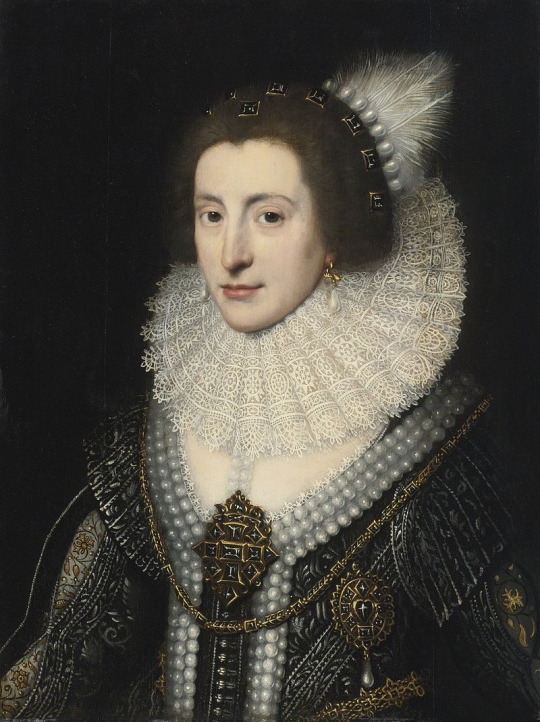
Elizabeth Stuart, Queen of Bohemia.
Portrait by the Workshop of Michiel Jansz. van Mierevelt, c. 1623.
Elizabeth was known as ‘the Winter Queen’, and her husband Frederick V as 'the Winter King’, due to their brief reign as monarchs of Bohemia. They were officially crowned in 1619, but were driven into exile after just one winter [Note: Henry VII, father of Henry VIII, was also known as 'the Winter King’. See documentary here.]
Her biographical details and regal connections are far too complicated to go into here - I suggest a read on Wikipedia and then further afield if you are sufficiently interested. Essentially, she was the second child and eldest daughter of James VI and I, King of Scotland, England, and Ireland, and his wife, Anne of Denmark, and became second-in-line to the throne when her elder brother, Henry Frederick, Prince of Wales, died at the age of 18 of typhoid fever. However, he was eventually succeeded by his younger brother, Charles, as Charles I, as mentioned in previous post here.
Elizabeth’s grandson by her daughter Sophia of Hanover succeeded to the British throne as George I, initiating the House of Hanover, when Queen Anne failed to produce any offspring despite 17 pregnancies.
ADD MORE INFO/EDIT.
2 notes
·
View notes
Text
Van Vliet's Interor of the Oude Kerk, Delft
Wow. 15 episodes and eight months. This episode is the season finale. I hope you’ve had as much fun listening as I’ve had talking to you. I really appreciate you spending your time with me and taking this tour.
Welcome to Long Live Bat Art, the podcast for art lovers who don’t see art as much as they want to. My name is Sydney and thank you for taking this slow tour through an art gallery with a casual art lover. Today, I’ll be talking about Interior of the Oude Kerk, Delft by Hendrick van Vliet. I hope you enjoy.
Hendrick Corneliszoon van Vliet was born in either 1611 or 1612 in Delft. He studied under his uncle Willem van der Vliet, and was admitted to the Painter’s Guild in Delft in 1632. That painter’s guild, as I’m sure you’ve been able to guess by now, was known as the St. Luke’s Guild. Van Vliet was adept at perspectives in his interiors, mainly of churches, and later started portrait painting with Michiel Jansz van Mierevelt.
Van Vliet married Cornelia van der Plaat in 1643. They had three children, two sons and a daughter. The sons’ names were Marinus and Cornelis, and they became painters. I couldn’t find the daughter’s name, but she apparently took care of her parents when they got older.
Van Vliet died in 1675 in apparent poverty, and ended up being buried in the same church he painted that features in today’s episode, Oude Kerk or Old Church. Twenty-three of his works survive.
On to the painting.
The painting is of the interior of a high-ceilinged building, most likely a church. The building is mostly white- columns, walls, and doorways. There is brown wood in the image, almost rosy in color. On the right of the image, in the foreground, is a wood object. It looks almost like a pew. The back, which is what the viewer can see, has what may be a place to kneel, but it isn’t cushioned like any of the churches I’ve ever been in. The top of the possible-pew is angled, stretching into the space of the painting and then dropping into the front of the pew. You can see what looks like a footrest for whoever would sit in the pew. In front of the pew are two columns, spaced a little farther apart than the length of the pew.
The columns are white stone with no other color in the material. The base of the columns are octagonal in shape- the sides are white and angled around the bottom. The very base of the columns are black. Above the base is a rounded band with two slimmer, flatter bands above it, each bringing the column in and making it slimmer. Above those is a shorter octagonal part, with the same bands capping it. These bands are casting shadows on the angled stones below it. The column continues upward smoothly, and is topped by an elaborately-carved capital. The carving broadens the column until it’s the same width of the base once more. The top is angled the same way as the lower part, as well. The carving is graceful and almost leaf-like or floral, with curved lines. The carving is gently split in half horizontally, with the lower half the same width as the column and the top the same width as the base. The carving’s transition is smooth, then it takes a sharp angle to the bands that top it.
Above the bands, the stones continue into a tall arch. You can see on other columns that the arch is slightly pointed, but you can’t see the top of this arch or the one to the left of the painting.
At the top of the wall, just before it curves to form the arch, is a wooden support beam. You can barely see the bottom, but you can see more of one on the support of the archway to the right. It extends up, probably to the ceiling or near to it, but it’s unclear because the painting cuts off before the end. Just before the very top of the painting, you can see the wood extends at an angle from the main part and the ceiling is wooden. You can’t actually tell that from the ceiling in the foreground are supporting, but in the midground there’s an opening that has the same columns and wooden supports. The ceiling is ribbed to provide further support.
Against the first column is a broom. Between the columns bracketing the pew are wooden boards and a pie of dirt that the cleaner had swept together. On the closest column, there’s a diamond design on the left side, angled so the viewer can see it. The outside is possibly a dark wood. The strip is wide and comes into the design. The inner part is deep red with gold details. It almost looks like it could be a representation of one of the Stations of the Cross, though I can’t tell which one it depicts if that’s even what it is. There’s a similar diamond design or sign on the column in the midground at an angle to the first one, and another one on the column behind that one.
The column to the right of the pew has a metal bracket on the shorter octagonal part above the base octagon. The bracket is swirled, almost like an ‘S’ if the letter had more swirls on either end before it ended. On the right of that column is a short wooden barrier with posts, almost like a wide ladder with unusually-close rungs. The barrier is around a column, but it takes a sharp turn deeper into the space of the painting and joins a wooden structure.
The structure is large, wider than the columns. It’s attached to the column the barrier is also protecting. The wooden structure is split almost halfway up the column. The top part isn’t connected to the base. The top part starts with a wide-bottomed angled shape. I can see at least seven sides, but it’s connected to the column so there’s room for another side if it was free standing. Set into and on top of the brim of the top part is a dome supported by arches. The dome has a tower in the center, with thin supports. Above the supports is a smaller part of the structure, more thin supports, then a similar part. These parts look like, since I promised myself I would be honest with you, cartoon hamburgers. The bottom is flat, the middle has a slightly wider part where the burger would go, then the top is rounded. Above the smaller ‘hamburger’ are two ovals, the top one smaller than the one below it. The very top of the design is a disk topped by a small, thin protrusion. Think a toy top.
In the center of the room is another dark wood structure. This one is short, only about two people high. The base is solid, then there’s an empty space, then it continues to a flat top. It looks like a ticket booth for parking lots or carnivals. In front of that is a man. He’s in profile and his face isn’t discernible. He’s wearing a long tan coat, the color of a classic trench coat. You can barely see a strip of white above it where his shirt shows. He’s wearing a flat black hat, almost a beret. His pants are also black. Above the ticket booth is a brass chandelier, with two levels of arms for candles. The arms are curved- extending out from the center, coming down, then swooping up half the dropped distance into the resting area for the candle.
Further into the background and at the left of the painting, the room opens up into a brighter area. It’s similar to the closer room, with the same columns and a chandelier. There are two men talking, one swearing a brown coat and the other a black. Both are wearing hats that match their coats. Further into the room is another figure you can barely see. He’s walking towards a doorway.
In the midground on the right of the image is an open wooden gate. The gate doesn’t extend to the ceiling. There are two men past the gate, and a woman and child walking towards the foreground. The men are almost identically dressed with brown coats, white shirts, and dark hats. Makes me wonder if they’re debating who should go home and change. The woman is wearing a deep red skirt with a blue shirt. She has a white bonnet on her head. The child barely comes up to her hip and is wearing a brown coat.
Beyond the gate is a similar structure as the one in the midground- the one topped with hamburgers, not the ticket booth. This one doesn’t have the spindle, however.
The area above the columns look like walls. The walls form a right angle with the left side being further into the painting. The right side comes closer to the viewer and is then hidden by the columns in the midground. The wall continues between the columns into the background. Above the walls are what look like stone barriers as if there’s a second floor. But the barriers are below windows- there’s no space between them for a balcony. The floor is dark gray square tiles, probably of stone.
Now for my thoughts.
The details in the painting- the white striand of shirts, the hats, the color of the faces even though features can’t be made out. It’s all so recognizable for exactly what it is. Van Vliet executed his vision. I chose this piece, which was right next to a similar painting of the same church from a slightly different angle. The other one seemed a bit more…dull, for lack of a better word. Not in subject matter, but muted in colors. It was just as detailed, and just as realistic, but I liked van Vliet’s better. It’s brighter and it’s more interesting to me. I don’t know why I was drawn to this painting, like most of the ones I chose.
I thought it was interesting that the people in this painting are off in the distance. The focus is on the space, and there isn’t even a ceremony or celebration or other event going on. It’s just the interior of a church. It’s beautiful, but when I was in the exhibit people walked by this painting or only stopped for a moment or two. There were other pieces in the exhibit, of course, but this one just…captured me. Maybe it’s because of the almost-emptiness of the space. It’s peaceful and light, and you can almost miss seeing the people entirely. It seems like a good place to pray or gather your thoughts.
The paintings I tend to like have a certain presence to them. It doesn’t have to be large in size or fantastic in terms of subject matter or even how famous the artist is- I actually chose The Milkmaid before I realized it was a Vermeer, after all. The painting can be simple, but I think there has to be an emotion I connect with. I don’t always know what emotion it is, but I think I need to see myself reflected back for me to enjoy a piece. It could be an experience I’ve never had, or in a place I’ve never been to, but there’s a common humanity that I can see. Some human experience or emotion- talking, doing chores, or longing, loneliness, pleasure. Just something I can easily see and identify. It often takes some time for me to realize why I chose a particular painting for you all. Sometimes I still don’t know after thinking for some time, and as I said in episode thirteen, that’s alright. You can’t dissect enjoyment, otherwise you can overthink it to death. You’re allowed to just be.
My final challenge for you this season is this: create. I don’t care if it’s a painting, or a poem, or a short story, or a clay bowl. Just create. Creation is both human and divine, but sharing that creation in uniquely human. Creating and sharing is something that we all do, something that no matter what we intend we show our hand of whoever we are. Everything is a statement, and everything you do shows another facet of yourself. And every facet of yours is beautiful.
If there’s one thing I want you to take away from this whole season it’s that people have always been people. They had fun and laughed and mourned and prepared food and did chores and played music and slept and worked and made mistakes just like people do today. Like I said- there’s a common humanity threaded throughout time and space. I’ve never been to any country where these artists came from. But they saw the same things I do today, and they decided to memorialize it. And the fact that they did means that they’re still reaching across time, showing me what they saw and what they loved. And I don’t know about you, but I’ll gladly take that guiding hand.
If you liked this episode of Long Live Bat Art, please consider telling a friend and reviewing to help the podcast grow. A link to the transcript of this episode is available in the show notes below. And you can follow me on Twitter at Long Live Bat Art and tumblr at tumblr dot com forward slash Long Live Bat Art. That’s Long Live B-A-T Art. Thank you for listening to this episode, and I will see you in July.
0 notes
Text
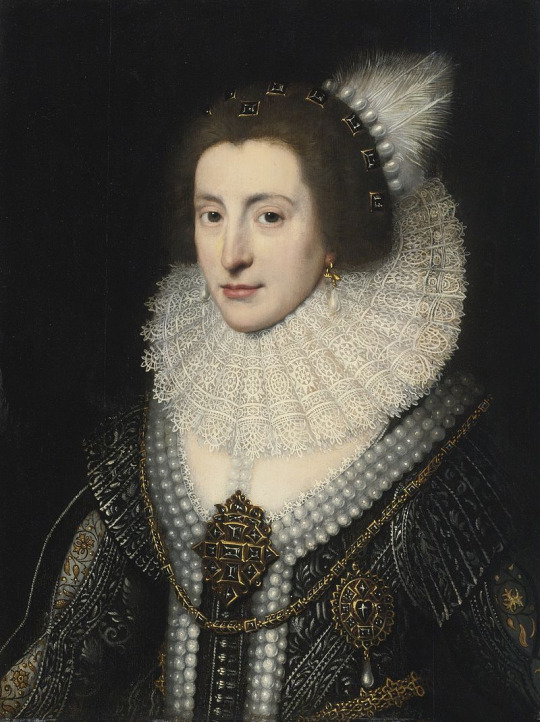
Elizabeth Stuart, Queen of Bohemia.
Portrait by the Workshop of Michiel Jansz. van Mierevelt, c. 1623.
Elizabeth was known as 'the Winter Queen', and her husband Frederick V as 'the Winter King', due to their brief reign as monarchs of Bohemia. They were officially crowned in 1619, but were driven into exile after just one winter [Note: Henry VII, father of Henry VIII, was also known as 'the Winter King'. See documentary here.]
Her biographical details and regal connections are far too complicated to go into here - I suggest a read on Wikipedia and then further afield if you are sufficiently interested. Essentially, she was the second child and eldest daughter of James VI and I, King of Scotland, England, and Ireland, and his wife, Anne of Denmark, and became second-in-line to the throne when her elder brother, Henry Frederick, Prince of Wales, died at the age of 18 of typhoid fever. However, he was eventually succeeded by his younger brother, Charles, as Charles I, as mentioned in previous post here.
Elizabeth's grandson by her daughter Sophia of Hanover succeeded to the British throne as George I, initiating the House of Hanover, when Queen Anne failed to produce any offspring despite 17 pregnancies (she's the subject of a film released in 2018 starring Olivia Colman, 'The Favourite' - I haven't seen it).
I do find this period of history really complicated. Basically, the line of succession after the death of Elizabeth I is as follows:
James I of England & Ireland, and VI of Scotland - r. 1603 - 1625. Son of Mary Queen of Scots and her second husband Henry Stuart, Lord Darnley (who was later murdered, allegedly by Mary's prospective third husband, James Hepburn, 4th Earl of Bothwell]. He was already James VI of Scotland when Elizabeth I died. His coronation united the two crowns, though I'm a bit confused about the exact details, or where Ireland fits into it all.
Charles I - r. 1625 - beheaded in 1649. The period between his execution and the Restoration of the Crown to his son Charles II was called 'The Interregnum'. It was during this time that Oliver Cromwell became Lord Protector (1653 - 58). After his death followed a brief period unsuccessful leadership by his son until the monarchy was restored in 1660. I find this period of history confusing and not of any real interest to me. It just seems to be about a load of unpleasant men fighting for control (aka The English Civil Wars.)
Charles II - r. 1660 - 1685. I don't know much about him, except he was known as 'The Merry Monarch', liked to party and had loads of illegitimate children, but none by his spouse, the Portuguese Catherine of Braganza. Henceforth, upon his death the crown went to his brother, James.
James II of England & Ireland, and VII of Scotland – r. 1685 – 1688. I know nothing about him other than he was married to a woman called Anne Hyde before he came king (I have mentioned her somewhere in an earlier post) and then Italian princess, Mary of Modena. He was succeed by his daughters Mary (along with her husband, the Dutch William of Orange, a grandson of Charles I, see link here) and then Anne.
Mary II of England co-ruled with her husband, who became William III – I haven’t got the dates of their reign to hand. Again, I’m very sketchy about this period of history, all I know is that their rule came about via the ‘Glorious Revolution’ and Protestant 'King Billy' has something to do with Northern Ireland (yeh, my knowledge in this area is really that slim). She died in 1694 and he ruled alone until his own death in 1702, when he was succeeded by Mary’s sister, Anne.
Anne – r. 1702 – 1714. No offspring despite 17 pregnancies, she was succeeded by George I, a German who spoke no English but who had a claim to the throne on account of him being the grandson of James I’s daughter – yep, back to where we started with the Winter Queen, Elizabeth of Bohemia. He would be the first of four Georges; the last of the Hanoverians were William IV and Queen Victoria.
Wow, quite a history lesson, especially for first thing Sunday morning! I will check it later for any errors. It all started simply, due to one of my scrapbook clippings from last night about Elizabeth of Bohemia, whom I'd not heard of before. It's really an attempt to consolidate my learning of this period after the Tudors, but I doubt I shall venture any further. As I've already mentioned here and in previous blog posts, these centuries don't hold much interest for me - a major reason why is I don't like much of the artworks created during these times, it's mainly all portraits of royals and aristocrats posing about in finery, or dull landscapes. But it's handy to try to commit to memory a timeline of who reigned when and the major political events which occurred in those eras.
1 note
·
View note
